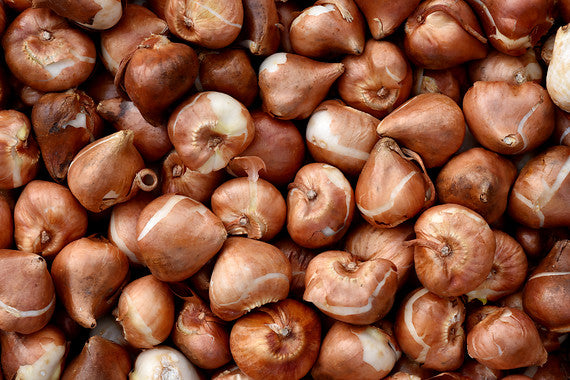For the impatient gardeners amongst us, having to wait until Autumn to buy tulip bulbs can feel akin to torture. But there’s a very good reason for holding tight and not buying your Spring bulbs - including tulips - during the winter, spring and summer months. Put simply, tulip bulbs bought outside of Autumn are unlikely to produce decent, if any, blooms.
Spring flowers including narcissi, crocuses, irises and of course tulips, are sold by reputable websites and garden centres during their planting season, which is Autumn. The reason for this is that the bulbs are harvested during the summer months and these fresh, healthy bulbs are then sold on for planting during Autumn. Once in the ground, these healthy bulbs start to produce roots and take their nourishment from the soil, readying themselves for the necessary cooling period over Winter. After the winter period, the healthy, nourished bulbs will bloom in Springtime, and after blooming they can be harvested during the summer months once more, and so the cycle begins again.
It’s simply not possible to have a ‘fresh’ tulip bulb in Springtime.
Unfortunately, not every home gardener will be aware of this, and unscrupulous garden centres, dealers and websites who really do know better, take advantage of their customers and are more than willing to overlook the important life cycle of the bulb in order to make money. This means that bulbs leftover from the Summer harvest are packaged and sold throughout the year, often lying out of the ground for several months, and in many cases, more than a year. Just as plants and flowers need water and nutrients, so do bulbs, so these neglected specimens are left to become mouldy or rot inside.
This happens worldwide – even in the world-renowned home of the tulip. If you happen to be visiting the Netherlands, you will likely find souvenir shops, market stalls and flower shops selling ‘fresh’ tulip bulbs throughout the year. But the same rule applies; no matter how convincing the seller is, or how appealing the packaging might be, resist buying any tulip bulbs between the months of January and August, as these bulbs are bound to be unhealthy and starved, and will not produce the promised blooms.
So, next time you are in a garden centre or flower shop, and you see a tempting array of tulip bulbs labelled as ‘fresh’ and being sold out with Autumn planting time, do resist the temptation. Instead of healthy, vibrant blooms, all that you are likely to grow is simply frustration and disappointment.
Preorders
Even the most impatient gardener can still plan ahead. You just need to find a trustworthy supplier, such as DutchGrown, and place your online orders early. You may not be able to have the bulbs physically in your hand, but you will have the security of knowing that the healthiest and freshest bulbs will be delivered directly to your house at the optimum time for planting, and you will be guaranteed the finest and strongest blooms. Trust us, it’s certainly worth holding out for.
And finally…Roses are red, Tulips aren’t blue
As a little postscript, this is another trick to be aware of. We’ve all seen those ads with convincing photographs of rainbow roses or bright blue tulips etc – colours that leap out at us because of their highly unusual nature. Well, buyer beware, – there is no such thing as a true-blue tulip. Tulips come in pretty much every colour of the rainbow, except blue. Next time you see a supplier offering a variety of tulip that looks too blue to be true, you know to give them a wide berth.

Life Cycle of the tulip bulb
1. September - October
Planting Time
The tulip bulbs have no roots at this stage and are ready to be planted. Most important: plant them
2. November
Planting Time and Making Roots
The roots begin growing out of the base and start to take their nourishment from the soil, readying themselves for Winter.
3. December - January
Cooling Period and Planting Time in some areas
Now begins the resting stage. In order for the bulbs to bloom in the spring, they need several weeks of cooling period. Frost at this time does not harm the bulbs.
4. February - March
Growing Period
The bulbs begin to change as the starch, or carbohydrates in them turn to sugar. As this occurs, the leaves and flower gradually push up-wards out of the bulb.
5. April - May
Blooming Time
The beautiful flowers appear. All of the energy of the bulb has gone to the bloom.
6. May - June
Regeneration
After the blooming period the dead flower heads are cut and the leaves are left on the plant. The new daughter-bulbs will use the leaves’ nutrients to grow.
7. July - September
Multiplying
Up to five small bulbs can be grow from a mother bulb. They form their roots slowly, and develop their blooms and leaves within the bulb, for the following year’s planting season.

